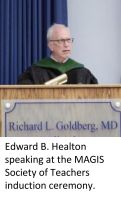Martin, Pahira Welcomed as Newest Members of MAGIS Society

Posted in GUMC Stories
May 19, 2017 – At the 15th annual MAGIS Society of Master Teachers induction ceremony, Mary Beth Martin, PhD, professor of oncology, and biochemistry and molecular & cellular biology, and John Pahira, MD, professor of urology, were welcomed as the newest members of the society, which honors physicians and biomedical scientists dedicated to the care of others and the health needs of our society.
Drawn from the Latin motto for the Society of Jesus, MAGIS is a Latin adverb meaning “more greatly” and is a shortened form of the Jesuit motto “ad maiorem Dei gloriam” or “towards the greater glory of God.” The additions of Martin and Pahira to the Society bring the total number of MAGIS Society members inducted since 2003 to 44. The May 18 ceremony took place in the Gorman Auditorium.
 “We recognize the MAGIS Society members for their exceptional commitment to generously sharing their broad knowledge and their time and for their formative impact in shaping our students as well as, of course, contributing to our continuing education of all of us and our colleagues,” said Edward B. Healton, MD, MPH, vice president for health sciences at GUMC and executive dean of the medical school.
“We recognize the MAGIS Society members for their exceptional commitment to generously sharing their broad knowledge and their time and for their formative impact in shaping our students as well as, of course, contributing to our continuing education of all of us and our colleagues,” said Edward B. Healton, MD, MPH, vice president for health sciences at GUMC and executive dean of the medical school.
Teaching Students About “The Wonderful, Intricate Workings of the Human Body”
As a professor in the departments of oncology and biochemistry and molecular biology, Mary Beth Martin, PhD, has drawn inspiration for her lectures from her fascination with human biology. Since starting her career at Georgetown in 1988, that bloom has only flourished.
“What I try to do in lecturing is convey the idea that biology is really, really interesting — that if we understand the biology and biochemistry, then we can design strategies to prevent and treat disease,” said Martin, who is also a member of the Georgetown Lombardi Comprehensive Cancer Center and the Center for the Study of Sex Differences in Health, Aging & Disease.
Martin conveys her appreciation of how cells work at a molecular level and how they interact with neighboring cells in tissue to first-year medical students who are eager to learn the basics. She expands medical students’ understanding of such things as transcription. These burgeoning physicians “know they need to understand the mechanisms behind treatment strategies in order to treat patients — and to help those same patients understand how these therapies are designed to help them,” she said.
She often uses cancer as an example of a disease that modifies a cell’s DNA, RNA and proteins, and how those maladjustments can be targeted. Martin may even mention her own research, which focuses on the way heavy metals in the environment appear to activate estrogen receptors and so may be linked to breast cancer.
Martin also teaches master’s and PhD students the nitty-gritty of isolating genetic material and the use of assays or tests to tackle biomedical problems. Core to all of her lectures is how to interpret and apply basic science methods students learn in the lab to determine what the findings mean for real patients. “The wonderful, intricate workings of the human body can tell us everything,” Martin said.
“… Something that all of us in the medical center aspire to …”
John Pahira was recruited to join the faculty at the School of Medicine in 1979 by a “great teacher and role model,” William C. Maxted, MD, former chief of urology and dean of the medical school. Since then, he has approached teaching third- and fourth-year medical students and residents with the same philosophy: “The difference between a good physician and a great physician is the ability to communicate with patients,” he said.
Helping physicians improve their communication skills was also the goal of a program Pahira developed at MedStar Georgetown University Hospital. He is an active member of the communication committee at the hospital, where he has served as president of the medical faculty and chair of both the hospital compliance committee and the credential committee.
In 1986, Pahira launched the first Center for Kidney Stone Disease in Washington, DC, where he has established a clinical rotation for urology residents from Washington area residencies as well as MGUH nephrology fellows and uro-gynecology fellows from MedStar Washington Hospital Center. He also established a mentoring program for a summer rotation in urology for undergraduate students who have expressed an interest in medicine.
Pahira has served as president of the Washington Urological Society and the mid-Atlantic section of the American Urological Society, and as a reviewer for the Journal of Urology, Journal of the American Family Physician and International Urology and Nephrology. In 2006, the urology residents presented him with the Maxted Outstanding Teacher of the Year Award, named for the man who had recruited him decades earlier.
Induction into the MAGIS Society “is in my opinion, one of the highest awards that the school offers for teaching. It is something that all of us in the medical center aspire to,” Pahira said. “When my peers honored me with the selection, I was both very proud and honored.”
Renee Twombly and Kat Zambon
GUMC Communications
